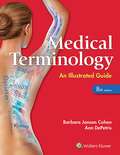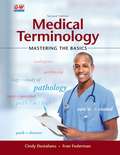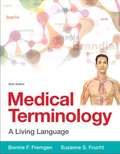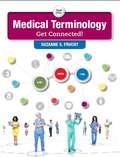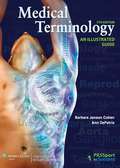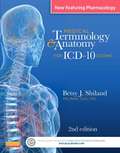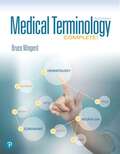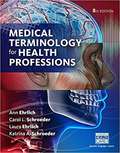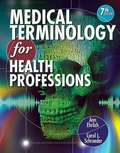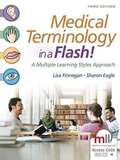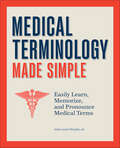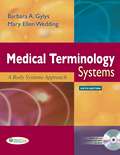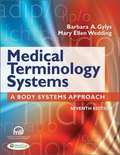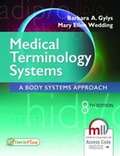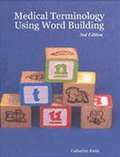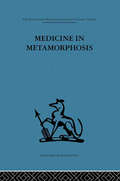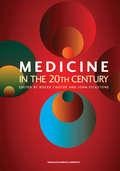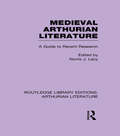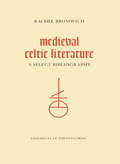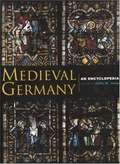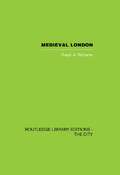- Table View
- List View
Medical Terminology: An Illustrated Guide
by Barbara Cohen Ann DePetrisNow packed with new illustrations and more clinically relevant than ever before, this fully updated Eighth Edition of Medical Terminology: An Illustrated Guide helps readers develop a fundamental knowledge of the medical terminology necessary for a career in any health care setting. To help students learn both medical terms and how they are used in real-world settings, this reader-friendly book demonstrates how medical terms are built from word parts (Part 1), introduces body structures, diseases, and treatments (Part 2), and covers each body system (Part 3). Accessible content, a logical organization, and reinforcing drills in every chapter combine to help readers master the information they need for success in their future careers. An enhanced art program, many new, clinically focused case studies, and an improved online teaching and learning resources (including PrepU adaptive quizzing) make this Eighth Edition ideal for classroom instruction, independent study, or distance learning. · Greater Student Confidence = Success: Use of Barbara Cohen's Memmlers Anatomy and Physiology along with this Medical Terminology text delivers continuity of writing style, design, and online resources making students more confident and ultimately more successful in their chosen health profession. · A greater emphasis on clinical illustrations brings concepts to life and helps students connect learning to practice. · Updated cases studies focus on current issues and hot topics to prepare students for the types of challenges they will encounter in practice. · PrepU is featured in the Ancillaries-at-a-Glance section and is identified with an icon throughout the text. · Online Student Resources have been updated and enhanced. · Online Lesson Plans have been updated with tips on using the book in a flipped classroom or in online learning.
Medical Terminology: Mastering the Basics
by Cindy Destafano Fran FedermanMedical Terminology: Mastering the Basics presents a solid introduction to basic medical terminology, providing you with the skills to communicate effectively using medical language in the healthcare field. Organized by body system, this work text covers essential root words, prefixes, suffixes, and abbreviations. It also summarizes basic anatomy and physiology, common diseases and disorders, diagnostic tests and procedures, and therapeutic treatments. Through completing numerous activities, you will learn the meanings of the word parts and will practice spelling, pronouncing, breaking down, and building medical terms. You will not only learn, but will also practice, using these terms to interpret examples of written and audio medical records you will encounter in healthcare.
Medical Terminology: A Living Language
by Bonnie F. Fremgen Suzanne S. FruchtWith 14 streamlined chapters covering essential A&P topics, this mid-sized book is the perfect fit for a one-semester course in medical terminology. It also serves as a useful reference for practicing professionals. Build a strong foundation of medical terminology, step by step Medical Terminology: A Living Language uses a carefully constructed learning system to help readers gain a successful grasp of medical language within a real-world context. Its step-by-step approach introduces the anatomy and physiology of body systems and their corresponding medical terms, as well as the rules of using word parts to form medical terms. New exercises and tips give readers the hands-on practice they need to achieve mastery. Rather than simply memorizing terms, students will gain the understanding to work with all terminology, regardless of its etymology or origins, so they can interpret unfamiliar terms they will encounter in the future. Also available with MyMedicalTerminologyLab(tm) This title is also available with MyMedicalTerminologyLab-an online homework, tutorial, and assessment program designed to work with this text to engage students and improve results. Within its structured environment, students practice what they learn, test their understanding, and pursue a personalized study plan that helps them better absorb course material and understand difficult concepts. No matter their learning style, students will build a solid foundation of medical language through MyMedicalTerminologyLab's interactive games, Dynamic Study Modules, and narrated lectures. NOTE: You are purchasing a standalone product; MyMedicalTerminologyLab does not come packaged with this content. MyMedicalTerminologyLab should only be purchased when required by an instructor.
Medical Terminology: A Living Language
by Bonnie F. Fremgen Suzanne S. Frucht Marcelo OliverNIMAC-sourced textbook
Medical Terminology: Get Connected!
by Suzanne FruchtA fun, accessible way to connect with medical terminology Successful healthcare professionals make connections every day--whether it is connecting word parts to make medical terms, recognizing the interconnectedness of body structures and systems, or communicating with colleagues and patients. Medical Terminology: Get Connected prepares readers to make these connections. Designed to be fun, accessible, and eye-catching, its powerful approach guides students step-by-step through mastering relevant word parts, understanding word roots, and word assembly. To help students learn meanings, correct spelling, pronunciation, and other components of each term, the book contains numerous exercises, tips, and colorful figures. As they practice and apply what they read, students will learn to build, translate, and link medical terms with confidence.
Medical Terminology 350: Learning Guide (2nd Edition)
by Dean VaughnThe purpose of this book is to teach you the basic design of medical terminology and how to easily remember the meanings of 350 Latin and Greek word parts or elements.
Medical Terminology,7th Edition,An Illustrated Guide
by Barbara Janson Cohen Ann DepetrisMedical Terminology: An Illustrated Guide, 7e by Barbara Janson Cohen uses a stepwise approach to learning medical terminology. Part 1 describes how medical terms are built from word parts; Part 2 introduces body structures, diseases, and treatments; and Part 3 describes each body system. Individual chapters also build on knowledge in stages: the Key Terms sections list the terms most commonly used; more specialized terms are included in a later section entitled “Supplementary Terms.”<P> The current edition includes a robust student ancillary package delivered under the PASSport to Success brand, with assessment exercises, chapter quizzes, and searchable text online, and a complete suite of instructor resources. The addition of PrepU as a packaging option provides a powerful value to students - the online study experience helps them to understand and retain course information and helps instructors to better assess what their students may be struggling with.
Medical Terminology And Anatomy For ICD-10 Coding (Second Edition)
by Betsy J. ShilandMedical Terminology and Anatomy for ICD-10 Coding integrates expanded anatomy, physiology, and pharmacology coverage with the latest medical terminology you need to correctly code in ICD-10. The ICD-10-CM classification system serves as the structure for organizing diseases and disorders, with carefully drawn, well-labeled illustrations to help you visualize the associated anatomy. ICD-10 coding guidelines and notes, along with electronic medical records and integrated exercises are interspersed throughout the text. A robust Evolve site includes games, activities, and animations to reinforce learning. Medical terminology specifically tailored to ICD-10-CM and ICD-10-PCS guidelines supply you with an excellent foundation for learning the medical terminology related to ICD-10-CM. Learn all the anatomy and physiology necessary to be able to understand medical reports and code accurately in ICD-10-CM/PCS. Pathology terms organized by ICD-10 disease and disorder categories let you learn terms in the same order they are presented in the coding manual. Guideline Alert! boxes highlight ICD-10-PCS coding information when relevant to medical terminology. Special Notes boxes present ICD-10 features that affect your understanding of the terminology presented. Root operation tables illustrate the root operations in PCS and their associated suffixes. Body Part key provides a complete list of body parts and how they should be coded in ICD-10. Pathology and procedure terminology tables list the word parts for each term, along with the definition so you become familiar with prefixes, suffixes, and combining forms. Exercises interspersed throughout the text encourage you to practice and learn as you move through the material. Be Careful! boxes warn you about similar and potentially confusing word parts and medical terms. Games and activities on accompanying Evolve website offer an easily accessible source for extra interactive practice and learning. Electronic medical record format illustrates the appearance of electronic records now being used in many healthcare settings. NEW! Pharmacology in each body system and a Pharmacology Basics appendix help you recognize drugs and medications in medical reports. NEW! More than 50 new images bring terminology to life. NEW! Additional procedural terms supply a more complete picture of the number and kind of procedures you will encounter on medical reports. NEW! Normal Lab Values appendix familiarizes you with normal and abnormal lab values so you know when to search a medical record for possible additional diagnoses. NEW! Tablet and mobile-optimized Evolve activities offer an easily accessible source for extra interactive practice and learning.
Medical Terminology Complete!
by Bruce WingerdMedical Terminology Complete! takes a programmed approach to presenting the most current language of healthcare. Organized by body system, the text conveys the medical terms used in medical offices, hospitals and clinics, together with essential A&P information. You'll get step-by-step guidance in building medical terms. Word Part Reminders show you how word parts combine to form a term, while Word Part Breakdowns identify word parts. Some exercises offer word-building practice, while others use medical reports to show how medical terms are used in practice. The 4th Edition improves clinical training for students poised to a launch a healthcare career. New types of chapter-ending exercises, such as Define the Combining Form and Complete the Labels exercises, round out a comprehensive series of practice opportunities.
Medical Terminology For Health Professions
by Ann Ehrlich Carol L. SchroederEmphasizing current, relevant, "need-to-know" terms that will help you succeed in the health care field, MEDICAL TERMINOLOGY FOR HEALTH PROFESSIONS, 8E simplifies the process of memorizing complex medical terminology by focusing on the important word parts--common prefixes, suffixes and root words--to provide a foundation for learning hundreds of medical terms. Organized by body systems, chapters begin with an overview of the terminology related to the body's structures and functions, proceed through diseases and disorders, and end with diagnostic procedures and treatments. A proven combination of learning principles and exercises helps you master the language necessary to describe how the human body works, what goes wrong with it, and how it is treated. An updated art program features the latest terms and procedures as well as multi-cultural/multi-generational photos that accurately portray the opportunities available in today's medical field.
Medical Terminology for Health Professions
by Ann Ehrlich Carol L. SchroederUse a proven combination of learning principles and exercises to make learning medical terminology easier . Now in its 7th Edition, MEDICAL TERMINOLOGY FOR HEALTH PROFESSIONS simplifies the process of memorizing complex medical terminology by focusing on the important word parts -- the common prefixes, suffixes and root words -- to provide a foundation for learning hundreds of medical terms. Organized by body systems, the chapters begin with an overview of the terminology related to the body's structures and functions, then proceed through diseases and disorders, and finally diagnostic procedures and treatments. This helps students master the necessary language to describe how the human body works, what goes wrong with it, and how we treat it. Every chapter engages learners with the See and Say pronunciation system, intreractive excersizes, real life medical scenarios and critical thinking exercises. An updated art program includes illustrations that reflect the latest terms and procedures, and multi-cultural /multi-generational photos that accurately portray today's medical world. Built-in multimedia is included with the text on the StudyWare CD-ROM. This resource is packed full of activities that engage student with games, quizzes, animations, and an audio glossary -ultimately helping students study , prepare for exams, and achieve success . Optional workbook and online courseware is also available.
Medical Terminology for Health Professions
by Ann Ehrlich Carol L. Schroeder Laura Ehrlich Katrina Schroeder SmithUpdated to reflect real-world practice, Schroeder/Ehrlich/Schroeder Smith/Ehrlich's MEDICAL TERMINOLOGY FOR HEALTH PROFESSIONS, 9E focuses on the current, relevant terms students need to know to succeed in health care. The program simplifies the process of memorizing complex medical terms by focusing on the importance of word parts -- common prefixes, suffixes and root words -- that provide the basis for most medical terms. In each chapter, learners practice the pronunciation and understanding of key terms through interactive activities, real-life medical scenarios and critical thinking exercises. The latest edition of this market leader includes expanded coverage of gender identity and gender reassignment, COVID-19, durable medical equipment, dental procedures, diabetic pathology, and more.
Medical Terminology in a Flash!: A Multiple Learning Styles Approach
by Lisa Finnegan Sharon EagleMedical Language Lab for Medical Terminology in a Flash! 3rd Edition www.MedicalLanguageLab.com Instant Access: 978-0-8036-4253-9 Access Card: 978-0-8036-5703-8 <p><p>How do you learn best? The 3rd Edition of this popular text features an emphasis on meeting the needs of all learning styles by providing a visually rich text, an online learning program, and perforated/tear-out flash cards at the back of the book. The online learning program, the Medical Language Lab 2.0, is included with the text and comes with lecture videos and an integrated e-book. (See below for details.) <p><p>You’ll discover how to make different study strategies work for you, whether your preference for learning is auditory, visual, kinesthetic, oral-dependent, or writing-dependent learner. Online. Interactive. Progressive. <p><p>The Medical Language Lab 2.0 is the interactive, online program that ensures you master the language of medicine. Based on proven language methodology, it guides you step by step from basic through advanced levels of proficiency to become a confident medical language speaker. <p><p>A special code in the front of the book unlocks The MLL for you…including an ebook of the text and lecture videos. Instructors can use it with their current learning management system or with its integrated grade book. They can also customize it to meet the needs of their course. Want to learn more? Visit the Medical Language Lab now. Instructors - request preview access and explore Medical Language Lab using this step-by-step walkthrough.
Medical Terminology in a Flash! A Multiple Learning Styles Approach: A Multiple Learning Styles Approach
by Lisa Finnegan Sharon EagleNIMAC-sourced textbook
Medical Terminology Made Simple: Easily Learn, Memorize, and Pronounce Medical Terms
by John TempleYour handy guide to understanding medical and healthcare termsWhen it comes to communicating with your doctor, mastering healthcare terminology you might hear from them is essential. Knowing what these words mean can help you ask the right questions and better understand your body, medical conditions, and any health guidance you receive. This medical reference book makes it easier to get familiar with common medical terms, so you feel more confident navigating your own care.Practical vocabulary—This mini medical dictionary focuses only on the most common and useful terminology so it's small enough to carry with you and easy to find the information you need.Break down each word—Did you know that hypotension means low blood pressure and hypertension means high blood pressure? Learn the anatomy of different medical terms so you can understand how they relate to each other.Feel prepared—Know the right words to use when you understand how doctors think and how to talk to them when.Learn the language of medicine with Medical Terminology Made Simple.
Medical Terminology Systems: A Body Systems Approach (6th edition)
by Barbara A. Gylys Mary Ellen WeddingThe book includes: A CLEAR, CONCISE PRESENTATION using the classic word-building and body systems approach to learning, CHAPTER OUTLINES to orient students to each chapter’s content, HOW DOES WORD BUILDING WORK? it begins with the basics, KEY TERMS highlighted in the beginning of each chapter, and ABBREVIATIONS for common terms.
Medical Terminology Systems 7th Edition
by Barbara A. Gylys Mary Ellen WeddingA word building and body systems approach to learning medical terminology. You’ll begin by learning the parts of words—roots, combining forms, suffixes, and prefixes. Then, use your understanding of word parts to learn medical terminology. Mnemonic devices and engaging, interactive activities make word-building fun and easy, ensuring you retain the information you need for success.
Medical Terminology Systems (Eighth Edition): A Body Systems Approach
by Barbara A. Gylys Mary Ellen WeddingBuilding on the success of previous editions, Medical Terminology Systems, 8th edition, continues its well-established record of presenting medical word building principles based on competency-based curricula.
Medical Terminology Using Word Building
by Catherine KurtzThis is a great course for beginners, the experienced, and everyone in between! This course teaches what we call Word Building, which is the knowledge of how all medical words are structured. It's a quick, efficient and amazingly easy way for anyone to learn medical terminology. You learn how to recognize the meaning of a medical term by dividing the word into its three basic component parts: the prefix, root and suffix. By knowing the meanings of the prefixes, suffixes, and root words, you can easily make sense of a medical term. This course is designed for the healthcare claims biller, the medical insurance claims adjuster, the medical office worker, or anyone wanting to learn medical terminology. The course takes the average person 3 weeks or less to complete based on a study time of 1-2 hours per day.
Medicine in Metamorphosis: Speech, presence and integration
by Martti SiiralaTavistock Press was established as a co-operative venture between the Tavistock Institute and Routledge & Kegan Paul (RKP) in the 1950s to produce a series of major contributions across the social sciences. This volume is part of a 2001 reissue of a selection of those important works which have since gone out of print, or are difficult to locate. Published by Routledge, 112 volumes in total are being brought together under the name The International Behavioural and Social Sciences Library: Classics from the Tavistock Press. Reproduced here in facsimile, this volume was originally published in 1969 and is available individually. The collection is also available in a number of themed mini-sets of between 5 and 13 volumes, or as a complete collection.
Medicine in the Twentieth Century
by Roger Cooter and John PickstoneDuring the twentieth century, medicine has been radically transformed and powerfully transformative. In 1900, western medicine was important to philanthropy and public health, but it was marginal to the state, the industrial economy and the welfare of most individuals. It is now central to these aspects of life. Our prospects seem increasingly dependent on the progress of bio-medical sciences and genetic technologies which promise to reshape future generations.The editors of Medicine in the Twentieth Century have commissioned over forty authoritative essays, written by historical specialists but intended for general audiences. Some concentrate on the political economy of medicine and health as it changed from period to period and varied between countries, others focus on understandings of the body, and a third set of essays explores transformations in some of the theatres of medicine and the changing experiences of different categories of practitioners and patients.
Medieval Arthurian Literature: A Guide to Recent Research (Routledge Library Editions: Arthurian Literature)
by Norris J. LacyThe focus of this book is medieval vernacular literature in Western Europe. Chapters are written by experts in the area and present the current scholarship at the time this book was originally published in 1996. Each chapter has a bibliography of important works in that area as well. This is a thorough and reliable guide to trends in research on medieval Arthuriana.
Medieval Celtic Literature: A Select Bibliography
by Rachel BromwichThe focus of this bibliography is the native literary tradition expressed in Irish and Welsh verse and prose from the earliest time to circa 1450. Priority is given to the most recent critical works and editions, provided that they supersede previous ones; however, earlier scholarly work and critical editions of texts that are now regarded as classics are also included. Because of the highly selective nature of this bibliography, Rachel Bromwich includes only a few studies on early legal texts, historical background, ecclesiastical learning, hagiography, archaeology and art, and folklore. The bibliography is divided into five chapters, of which two are intended for newcomers to the field and list the more available works of reference and aids to language study. The remaining three are devoted to literary history and criticism, texts and translations, and background material. The more than 500 entries have been arranged to show the ways in which the medieval literature of Ireland and Wales pursue parallel courses. In each chapter a general and comparative section is followed by sub-sections dealing with Irish material (including Cornish and Breton). Within each of these sub-sections individual items dealing with similar or closely related topics have been grouped together. Since this work is intended primarily for students working in English, the majority of the listings are in English, but important works in Irish, Welsh, French, and German are also cited.
Medieval Germany: An Encyclopedia
by John M. JeepThe book offers the most recent scholarship available, while also providing details on the daily life of medieval Germans. It covers every aspect of the German and Dutch speaking medieval world, between C.E.500 and 1500,individuals and their deeds as well as broader historical topics such as feudalism and pregnancy.
Medieval London
by Gwyn A. WilliamsThis unique study is based on the careful interpretation of evidence in the commercial and administrative records of the City and in the royal records, of the process by which London developed from a commune of a feudal kingdom into the capital city of the English nation. The period covered is the century and a half between 1191 and the beginnings of the Hundred Years' War. Leading themes are the emergence of its administrative elite, the changing pattern of its mercantile interests, and the rise of its craft organizations; and a detailed account is given of the social and constitutional conflicts that marked London's history between the popular revolt of 1263 and the succession of Edward III. A notable feature of this volume is the reconstruction from teh records of a large number of outline biographies of Londoners of all classes. This book was first published in 1963.
